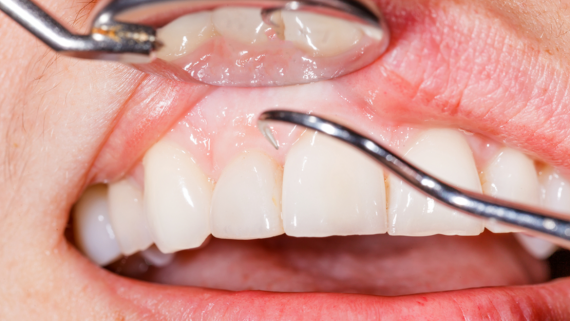What catches your attention more? The words “gum disease” or “periodontal disease.” We have a hunch that the word “disease” catches your attention, but that the word “gum” is easy to overlook. After all, it’s easy to overlook the importance of our gums compared to our teeth. Periodontal disease is gum disease and presents in two different ways: gingivitis and periodontitis.
Periodontal disease in the form of periodontitis affects approximately half of adults and is the leading cause of tooth loss in adults. It’s often and colloquially referred to as gum disease. Gingivitis is even more common but is — thankfully — relatively easily reversed and prevented. You’ve heard the words, and you’ve listened to a dentist near you explain the importance of good daily dental habits to avoid gum disease. What is gum disease, and what do you need to know about it?
What is gum disease?
Your gums play an essential role that is often and easily overlooked. Your gums support your teeth and protect the interior of your jaw and protect the roots of your teeth from exposure and the accumulation of bacteria and food particles that can cause an infection affecting your soft gum tissues.
Most frequently, gum disease is caused by poor oral hygiene habits that haven’t been up to the cause of preventing plaque from building up. Periodontal disease in Toronto Beaches presents in two ways, one more serious than the other: gingivitis; and periodontitis.
The two stages of gum disease
Gingivitis
Gingivitis is gum inflammation that is the earliest form of gum disease caused by the accumulation of plaque on your teeth and along the edges of your gums. Gingivitis is, if detected early, easily treated and halted. Professional teeth cleanings and a rededication to brushing, flossing, and mouthwash can be enough to resolve gingivitis and to prevent the development of more problematic periodontitis.
Periodontitis
The advanced form of gum disease called periodontitis does not damage just gums, but also affects the bone material that supports your teeth. The destruction of gum and bone material can destroy the essential physical support on which your teeth rely. That loss of support can cause them to loosen and eventually fall out. Periodontitis is preventable with good oral hygiene, but even the best oral hygiene practices are not sufficient to halt or resolve established periodontitis. To eliminate the presence and consequences of periodontitis, a periodontist will perform more invasive procedures such as scaling and cleaning the roots of the affected teeth.
What are the symptoms of gum disease?
Bleeding gums while flossing and brushing may indicate the presence of gum disease. That bleeding is caused by the accumulation of bacteria beneath your gums. That accumulation of bacteria makes those gums easily irritated during brushing and flossing. If your bleeding gums are caused by periodontitis, your gums may also look red and swollen.
Do your teeth look longer than they used to be? They aren’t actually getting any longer. What’s actually happening is that your gums are receding or shrinking away and towards the roots. Receding gums are a symptom of progressing gum disease. If your gums recede too far, they’ll eventually be unable to be reached and cleaned by brushing and flossing. The inevitable accumulation of food particles and bacteria will accelerate the development of periodontitis and cause even further recession — ultimately exposing the very roots of your teeth.
Occasionally and temporarily sensitive teeth are a common phenomenon even in a healthy mouth. Teeth sensitivity that persists beyond occasional and temporary discomfort, though, is also a symptom of progressive periodontal disease near you. In fact, periodontitis-associated sensitivity may indicate that gums have receded to the point that they’re unable to protect the roots of your teeth. If indeed the roots of the teeth are exposed due to receded gums, those roots are vulnerable to quick decay and ultimately tooth loss. During this stage, ongoing bad breath is common due to the accumulation of bacteria in and around your gums and the roots of your teeth.
The bad news is that gum disease is serious and, at its worst, can cause tooth loss. The good news, on the other hand, periodontal disease is preventable and treatable by a periodontist near you. The ease and effectiveness of treatment are determined in part by how long the gum disease has been present and how far it has progressed.
If you are experiencing any symptoms of gum disease in any form, don’t hesitate to see a dentist to learn about the best options for prevention and treatment.

